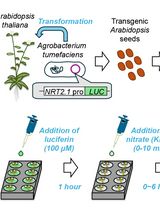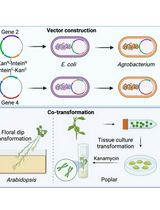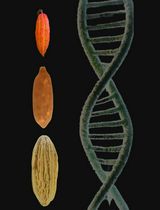- EN - English
- CN - 中文
Cellulase and Macerozyme-PEG-mediated Transformation of Moss Protoplasts
纤维素酶和离析酶-PEG介导的苔藓原生质体转化
发布: 2021年01月20日第11卷第2期 DOI: 10.21769/BioProtoc.3782 浏览次数: 4463
评审: Krishna SaharanJuliane K IshidaXiangqiang Kong
Abstract
This protocol describes the generation of protoplasts from protonemal tissue of the moss Physcomitrium patens (syn. Physcomitrella patens), using Cellulase ONOZUKA R10 and Macerozyme R10, followed by polyethylene glycol (PEG) mediated transformation. The protonemal tissue grown in liquid suspension was harvested and treated with enzyme cocktails mix of 1.5% Cellulase ONOZUKA R10 and 0.5% Macerozyme R10 to generate 1,8 million protoplasts within 3 h.
Keywords: Moss (苔藓)Background
Thanks to its efficiency in the natural homology directed repair Physcomitrium patens is ideal to use as a plant experimental system, especially for heterologous expression of genes, permitting the generation of transformants with predictable properties and characteristics. Moreover, P. patens has the advantage of low-cost cultivation and it can be maintained in large quantities in bioreactors (Reski et al., 2018). The genetic engineering of P. patens cells allows the large-scale production of natural products and drugs such as thapsigargin and other terpenoid drug candidates, which are difficult of access (Simonsen et al., 2009). This protocol shows how to isolate and transform P. patens protoplasts released from the haploid protonema filaments. P. patens has been already used for generation and PEG-mediated transformation of protoplasts. In the previous experiments protoplastation on P. patens is performed with the enzyme Driselase from Basidiomycetes (Cove et al.., 2009; Bach et al., 2014). With the model plant Arabidopsis thaliana, 60 min of incubation with constant shaking in darkness allows one to obtain a consistent amount of viable protoplasts (Fesenko et al., 2016). Although the Physcomitrium tissue digestion fulfilled by Driselase is highly efficient and fast (Bach et al., 2014; King et al., 2016), the instable delivery and availability of Driselase led to the study of a different procedure for protoplastation and to look for more widely used enzymes. Here we describe an alternative efficient method, using the enzyme Cellulase ONOZUKA R-10 in combination with Macerozyme R-10. Cellulases and pectinases have been successfully tested on different plants such as Fritillaria imperialis L. (Chamani and Tahami, 2016), Penium margaritaceum (Raimundo et al., 2018), Ananas comosus L. (Priyadarshani et al., 2018), Brassica oleracea L. and Brassica napus L. (Kaur et al., 2018) and it is regularly used on Arabidopsis thaliana (Abel and Theologis, 1994; Yoo et al., 2007), but to our knowledge it has not been published on P. patens. Additionally, in this protocol the incubation is performed without shaking. Further modifications of the experimental conditions could possibly optimize the protocol even more to yield more protoplasts.
Materials and Reagents
- FalconTM (Size 50 ml; D-51588)
- Cell strainers (70 µm nylon mesh, Fisher brand, catalog number: 22363548 )
- Cell strainers (40 µm nylon mesh, Fisher brand, catalog number: 22363547 )
- Round bottomed glass tube with screw cap (size: 11 ml; Pyrex, catalog number: 10004654 )
- Scalpel blade (Thermo ScientificTM 53221, catalog number: 12657776 )
- Petri-dishes (FisherbrandTM Polystyrene Petri Dishes, Sterile; size: 90 mm)
- Syringe filter (0.45 µm, FRISENETTE, catalog number: CALS2504100S )
- Sterile syringe (20 ml and 50 ml) (Chirana, catalog numbers: CH03020L; CH03050L )
- Sterile pipette tips (Labsolute, non-pyrogenic, single use, size: 50 ml, 10 ml, 5 ml)
- Moss (Physcomitrella patents) that is blended 4-5 days in advance (liquid culture) and grown at 16 h light/8 h dark cycle at 25 °C in presence of 5 mM of Ammonium Tartrate as described previously in Bach et al. (2014).
- Cellulase ONOZUKA R-10 1.5% (w/v) (DUCHEFA, catalog number: C8001.0010 , CAS No: 9012-54-8), storage temperature 2-8 °C
- Macerozyme R-10 0.5% (w/v) (DUCHEFA, catalog number: M8002.0010 , CAS No: 9032-75-1), storage temperature 2-8 °C
- D-Mannitol (Duchefa Biochemie, catalog number: M0803.5000 ; CAS No: 69-65-8)
- CaCl2 (SIGMA, catalog number: C3306-550G ; CAS number: 10035-04-8)
- MES hydrate (SIGMA, catalog number: M2933-1Kg )
- KOH (SIGMA, catalog number: 484016-1KG ; CAS No: 1310-58-3)
- Trizma base (SIGMA, catalog number: T6066-1Kg ; CAS no: 77-86-1)
- HCl (VWR Chemicals, catalog number: 20255.200 ; CAS no: 7647-01-0)
- Ca(NO3)2·4H2O (SIGMA, catalog number: C2788-500G ; CAS no: 13477-34-4)
- Polyethylene glycol (PEG, MW 6000) (SIGMA, catalog number: 81253-250G ; CAS no: 25322-68-3)
- MgCl2 (SIGMA, catalog number: M8266 ; CAS no: 7786-30-3)
- Agar, plant cell culture tested (Alfa Aesar, catalog number: H26724 ; CAS no: 9002-18-0)
- Ammonium tartrate (SIGMA, catalog number: 09985-250G ; CAS No: 3164-29-2)
- H3BO3
- MnCl2·4H2O
- AlK(SO4)2·12H2O
- CoCl2·6H2O
- CuSO4·5H2O
- ZnSO4·7H2O
- KBr
- KI
- LiCl
- SnCl2·2H2O
- 8.5% Mannitol (see Recipes)
- 1 M CaCl2 (see Recipes)
- 2 M KOH (see Recipes)
- 0.2 M MES pH 5.8 (see Recipes)
- Protoplast media (PM) (see Recipes)
- Protoplast wash solution (PW) (see Recipes)
- 0.4 M Tris-Cl pH 8.0 (see Recipes)
- PEG-MCT (see Recipes)
- 1 M MgCl2 (see Recipes)
- MMM solution (see Recipes)
- PRMB media (see Recipes)
- PRMT media (see Recipes)
- BCD Media (see Recipes)
- BCD Plate (see Recipes)
- 500 mM Ammonium tartrate (see Recipes)
Equipment
- Flasks, Erlenmeyer (1 L, sterile)
- Reagent bottles (500 ml, 250 ml, 100 ml)
- Serological pipette (Brand® Accu-jet® pro, catalog number: 19B17038 )
- Centrifuge (ThermoFisher, model: HeraeusTM MultifugeTM X1R )
- Haemocytometer (Neubauer-improved 0.1 mm, Superior MARIENFELD Germany; catalog number: 0650030 )
- Light microscope (OLYMPUS, BX40 )
- 30 °C incubator (Gerhardt Thermoshake)
- Scalpel handle (Thermo ScientificTM 53410, catalog number: 12667776 )
- Forceps (BochemTM 1020R, catalog number: 10333511 )
- Microwave (Whirlpool, GUSTO: GT285 )
- Sterile cellophane disks (Size: 80 mm, Company: Focus Packaging & Design Ltd, PKS150 70-01 , Batch: 05377)
- Surgical tape (Micropore, 1,25 cm X 9.1 m, ½ in x 10 yd, Ref: 1530-0 )
- Bunsen burner (Campingaz, Easy clicTM Plus; CV300 Plus )
- Laminar Air Flow Bench (LAF Bench)
- Water bath at 45 °C (MgW LAUDA MS)
- Rocker (Brand: Desaga, Starstedt-Gruppe)
- Homogeniser (IKA® T25 digital ULTRA TURRAX)
Procedure
文章信息
版权信息
© 2021 The Authors; exclusive licensee Bio-protocol LLC.
如何引用
Batth, R., Cuciurean, I. S., Kodiripaka, S. K., Rothman, S. S., Greisen, C. and Simonsen, H. T. (2021). Cellulase and Macerozyme-PEG-mediated Transformation of Moss Protoplasts. Bio-protocol 11(2): e3782. DOI: 10.21769/BioProtoc.3782.
分类
植物科学 > 植物分子生物学 > DNA
分子生物学 > DNA > 转化
您对这篇实验方法有问题吗?
在此处发布您的问题,我们将邀请本文作者来回答。同时,我们会将您的问题发布到Bio-protocol Exchange,以便寻求社区成员的帮助。
Share
Bluesky
X
Copy link















